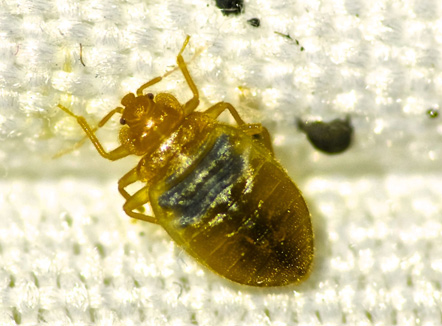BedBug Characteristics
|
Bedbugs are small, wingless insects found all over the world. They are nocturnal parasites, which means they rest during the day and are active at night. Bedbugs prefer to hide in bedding and on mattresses where they have ready access to a source of food. Bedbugs have highly developed mouth parts that can pierce skin. Their bite is painless. Some people do not react to the bites, but for others the bites can become itchy and swell into reddened weals. Although bedbugs can harbour diseases in their bodies, transmission to humans is highly unlikely. They are not dangerous, unless a person is allergic to them.  The characteristics of a bedbug include that they: The characteristics of a bedbug include that they:
Bedbugs live exclusively on blood. They prefer human blood, but will feed on other mammals if necessary. Bedbugs are attracted to body heat and the carbon dioxide in expired air, which is how they find their host. Bedbugs commonly target the shoulders and arms. The living areas favored by bedbugs include:
The first indication of a bedbug infestation may be the presence of bites on family members. A thorough inspection of your premises, especially the common hiding spots, may also reveal:
Our dogs are trained to detect bed bugs and are far more accurate than human-eye test. They can inspect a room in minutes with visual confirmation from their handler. We are certified through the Wisconsin Pest Control Association and the National Entomology Scent Detection Canine Association. If you think you have bed bugs contact us online or by phone at (608) 882-1508. |
|
Bedbugs are small, wingless insects found all over the world. They are nocturnal parasites, which means they rest during the day and are active at night. Bedbugs prefer to hide in bedding and on mattresses where they have ready access to a source of food. Bedbugs have highly developed mouth parts that can pierce skin. Their bite is painless. Some people do not react to the bites, but for others the bites can become itchy and swell into reddened weals. Although bedbugs can harbour diseases in their bodies, transmission to humans is highly unlikely. They are not dangerous, unless a person is allergic to them.  The characteristics of a bedbug include that they: The characteristics of a bedbug include that they:
Bedbugs live exclusively on blood. They prefer human blood, but will feed on other mammals if necessary. Bedbugs are attracted to body heat and the carbon dioxide in expired air, which is how they find their host. Bedbugs commonly target the shoulders and arms. The living areas favored by bedbugs include:
The first indication of a bedbug infestation may be the presence of bites on family members. A thorough inspection of your premises, especially the common hiding spots, may also reveal:
Our dogs are trained to detect bed bugs and are far more accurate than human-eye test. They can inspect a room in minutes with visual confirmation from their handler. We are certified through the Wisconsin Pest Control Association and the National Entomology Scent Detection Canine Association. If you think you have bed bugs contact us online or by phone at (608) 882-1508. |





